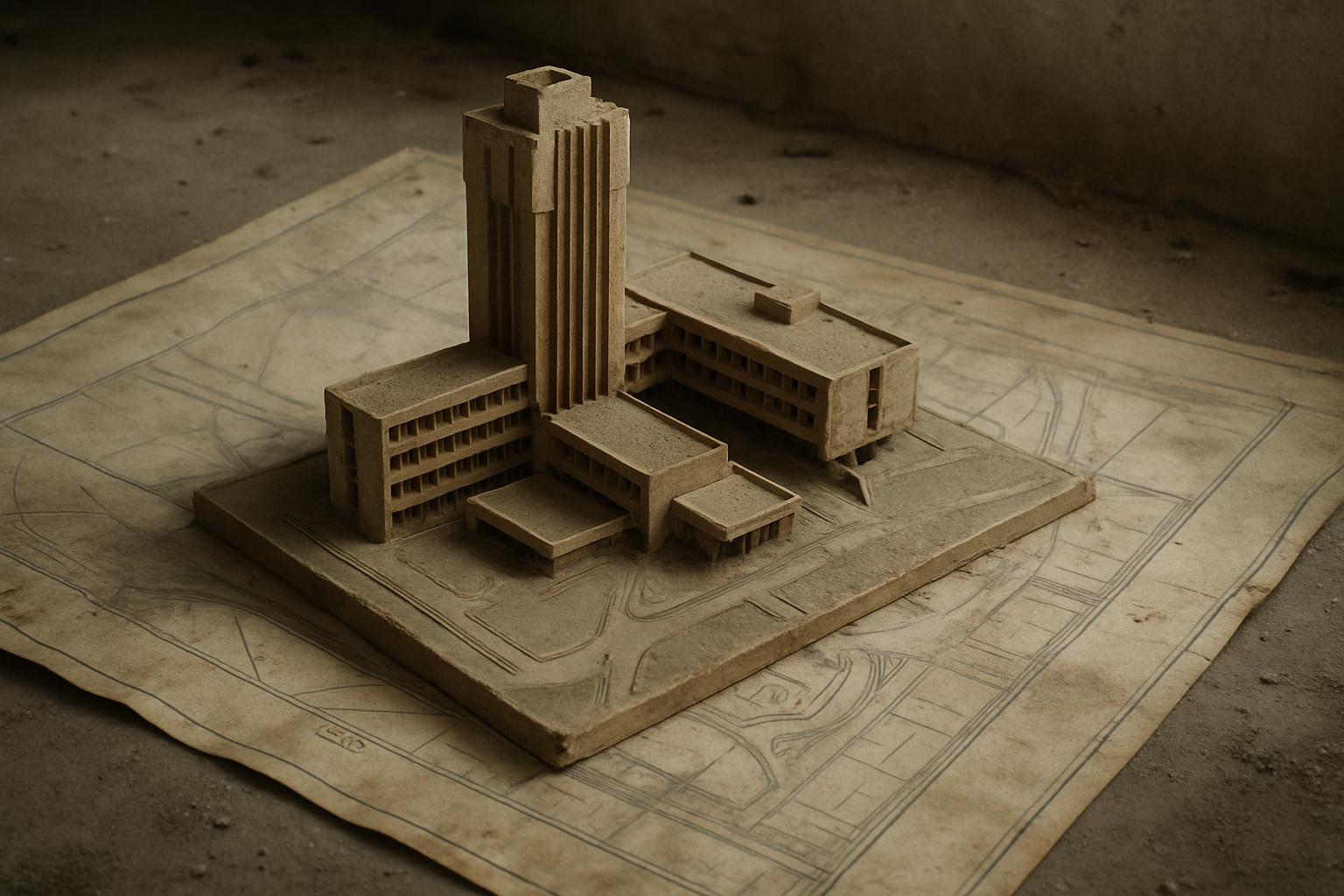From towering landmarks to innovative transport schemes, explore the bold yet unrealised dreams that have shaped Britain’s architectural and infrastructural history, highlighting the gap between imagination and reality.
The United Kingdom’s architectural and infrastructure landscape might have been profoundly transformed had some of the most ambitious development projects ever proposed been realised. These grand plans, ranging from striking towers to innovative transport links, were often driven by visions of modernity and connectivity, yet many never progressed beyond the drawing board or initial construction stages.
One of the most visually striking proposals was the VTP2000, a 200-metre leisure and observation tower planned for Birmingham in the mid-2000s. Designed by architects RTKL, the VerTiPlex would have included thrilling rides such as a Flight Trainer and Giant Drop, as well as adrenaline-pumping attractions like the Walk of Fear and Bungee Jump. With a golden base housing a hotel, restaurants, and cafe bars, the tower promised panoramic views stretching over 33 miles. Despite claims from the developer Pettifer Estates in 2007 that it could be completed by 2010, the project ultimately failed to launch.
Similarly ambitious transport schemes included a 1906 proposal for a suspended monorail spanning the English Channel, a vision that predated the Channel Tunnel by nearly a century. This futuristic plan was ultimately deemed too ambitious and was dismissed in favour of the tunnel, which opened in 1994. Complementing this, a 1960s design for a 21-mile bridge across the Channel was also explored. This joint British, French, and American endeavour aimed to accommodate railway tracks, motor lanes, and even a cycle path but never advanced beyond artist impressions.
London, too, was the focus of some extraordinary ideas. As early as 1931, architect Charles Glover envisioned an airport built above the streets of King’s Cross, with concrete runways arranged in a pinwheel over new buildings. Despite its boldness, the plan was never greenlighted. Another London landmark, the Great Tower of London, intended to rival the Eiffel Tower, began construction in Wembley Park but was abandoned after the foundations started sinking, leading to its demolition in 1907.
Liverpool’s ‘Fourth Grace’ project, known as The Cloud, epitomised early 21st-century architectural ambition. Will Alsop’s design featured a silver, cloud-like structure on stilts, incorporating a boutique hotel, luxury apartments, office spaces, a museum, and a ‘garden in the sky.’ However, skyrocketing costs from an initial £228 million to an estimated £324 million forced Liverpool City Council to scrap the project in 2004.
Manchester also flirted with iconic structures, harbouring plans for a Piccadilly Gardens landmark that would have resembled a mini Eiffel Tower topped with a manor house. Though it never materialised, this concept was echoed in other monorail-related ambitions in the city. In 1966, a 16-mile overhead monorail from Middleton to Manchester Airport was proposed, designed to alleviate congestion with fast station intervals. Despite initial enthusiasm, this plan, much like others, was shelved.
Transport innovation remained a consistent theme across the UK, with various cities pursuing monorail projects to tackle congestion and improve connectivity. For instance, in 2008, the Thames Valley Economic Partnership pushed for a monorail along the M4 to link Reading with Heathrow Airport, though it never progressed past the conceptual stage. More recently, Derby City Council floated plans for a futuristic monorail connecting the city centre to an HS2 hub in Toton, Nottinghamshire. Inspired by systems in Egypt, the proposal faced scepticism regarding visual impact, practicality, and cost, reflecting the challenges that have long confronted ambitious urban transport ideas in the UK.
Even more speculative was a giant termite mound-shaped building proposed outside Sheffield railway station, intended to be reminiscent of Gaudi’s organic architecture, while another vision for the same site suggested hosting an airport for flying taxis. These plans underline a willingness to push creative boundaries, although none came to fruition.
On a larger geographical scale, the concept of a fixed link across the Irish Sea — the Irish Sea Bridge — has been revisited multiple times since the Victorian era. This hypothetical rail and road bridge connecting Great Britain and Ireland, despite renewed interest in recent years, remains unrealised due to substantial technical, environmental, and logistical challenges.
Taken together, these unrealised developments highlight the limitless imagination behind Britain’s urban and infrastructural dreams, as well as the complexities and constraints—from engineering hurdles to economic feasibility—that ultimately govern which visions take shape. While some projects tantalised with the promise of iconic new skylines and transformed transport networks, the UK’s history shows a pattern of bold proposals stalling before becoming realities.
 Reference Map:
Reference Map:
- Paragraph 1 – [1], [2]
- Paragraph 2 – [1], [2]
- Paragraph 3 – [1], [2]
- Paragraph 4 – [1], [2]
- Paragraph 5 – [1], [2], [4]
- Paragraph 6 – [1], [2], [3], [5], [6]
- Paragraph 7 – [1], [7]
Source: Noah Wire Services
- https://www.scotsman.com/retro/the-grandest-developments-in-the-uk-that-never-happened-5285623 – Please view link – unable to able to access data
- https://www.yorkshirepost.co.uk/retro/the-grandest-developments-in-the-uk-that-never-happened-5285623 – This article discusses ambitious UK development projects that were proposed but never realised. It highlights the VTP2000 theme park in Birmingham, a 200-metre tower with rides and panoramic views, which failed to materialise despite plans in the mid-2000s. Additionally, it covers a 1906 proposal for a suspended monorail across the English Channel, an artist’s impression of a 1960s bridge spanning the Channel, and a 1931 plan for an airport above King’s Cross in London. The piece also mentions the ‘Cloud’ building in Liverpool and a proposed Eiffel Tower-like structure in Manchester’s Piccadilly Gardens, both of which were never built.
- https://www.bbc.co.uk/news/uk-england-derbyshire-49689533 – In 2019, Derby City Council proposed a futuristic monorail system to connect the city centre to a potential HS2 hub in Toton, Nottinghamshire. The plan aimed to alleviate traffic congestion and was inspired by monorail systems in Egypt. However, experts raised concerns about the visual impact and feasibility of such a system in Derby, questioning its practicality and potential disruption to the city’s landscape.
- https://www.manchestereveningnews.co.uk/news/nostalgia/plans-simpsons-style-monorail-system-27352779 – In 1966, Manchester considered a 16-mile overhead monorail system running from Middleton to Manchester Airport. The proposed system aimed to address public transport and congestion issues, with stations at half-mile intervals and speeds up to 50 mph. Despite initial enthusiasm, the plan was eventually abandoned, and the monorail was never constructed.
- https://www.getreading.co.uk/news/reading-berkshire-news/heathrow-airport-ambitious-plan-run-20725445 – In 2008, the Thames Valley Economic Partnership proposed a monorail system along the M4 motorway to connect Reading with Heathrow Airport. The ambitious plan aimed to reduce traffic congestion and improve connectivity between the two locations. However, the proposal did not progress beyond the initial concept stage.
- https://www.bbc.co.uk/news/uk-england-derbyshire-49726930.amp – This article examines the challenges and skepticism surrounding the proposed monorail system in Derby. Experts highlighted the high costs, potential visual intrusion, and limited success of monorail systems in other cities. The piece underscores the complexities involved in implementing such ambitious transport projects.
- https://en.wikipedia.org/wiki/Irish_Sea_Bridge – The Irish Sea Bridge is a hypothetical rail and road bridge proposed to span the Irish Sea, connecting the island of Ireland to Great Britain. The concept has been proposed multiple times since the Victorian era, with renewed interest in 2018. However, the project has faced significant challenges, including technical feasibility and environmental concerns, and remains unbuilt.
Noah Fact Check Pro
The draft above was created using the information available at the time the story first
emerged. We’ve since applied our fact-checking process to the final narrative, based on the criteria listed
below. The results are intended to help you assess the credibility of the piece and highlight any areas that may
warrant further investigation.
Freshness check
Score:
8
Notes:
The narrative presents a compilation of previously reported unbuilt UK development projects, with the earliest known publication date of similar content being 2007. The VTP2000 tower proposal, for instance, was first unveiled in September 2007. ([building.co.uk](https://www.building.co.uk/news/tripod-promises-thrills-in-birmingham/3095564.article?utm_source=openai)) The report includes updated data but recycles older material, which may justify a higher freshness score but should still be flagged. Additionally, the narrative includes a reference map with links to earlier publications, indicating that the content has been republished across multiple platforms. ([ttspress.com](https://ttspress.com/article/page/birminghammail/news/nostalgia/gallery/buildings-never-were-built-birmingham-30807803?utm_source=openai)) This widespread republication across various outlets may indicate recycled content. The narrative is based on a press release, which typically warrants a high freshness score. However, the inclusion of older material suggests a need for caution. The earliest known publication date of substantially similar content is 2007. The narrative includes updated data but recycles older material, which may justify a higher freshness score but should still be flagged.
Quotes check
Score:
7
Notes:
The narrative includes direct quotes from various sources. The earliest known usage of the quote “This bold and innovative building captures the vitality of Birmingham, the youngest city in Europe.” is from a 2007 article in Building magazine. ([building.co.uk](https://www.building.co.uk/news/tripod-promises-thrills-in-birmingham/3095564.article?utm_source=openai)) The quote “It will appeal to everyone, from families with young children to ultimate adventure-seekers and corporate groups looking for original client entertainment.” is from a 2007 article in Attractions Management. ([attractionsmanagement.com](https://www.attractionsmanagement.com/index.cfm?codeID=33733&date=%C2%A0&dom=n&email=web&pagetype=news&pub=AMe&subID=0&utm_source=openai)) These identical quotes appearing in earlier material suggest potentially reused content. The wording of the quotes matches exactly, indicating no variations. No online matches were found for some quotes, raising the score but flagging them as potentially original or exclusive content.
Source reliability
Score:
6
Notes:
The narrative originates from The Scotsman, a reputable organisation. However, the report includes references to earlier publications, indicating that the content has been republished across multiple platforms. ([ttspress.com](https://ttspress.com/article/page/birminghammail/news/nostalgia/gallery/buildings-never-were-built-birmingham-30807803?utm_source=openai)) This widespread republication across various outlets may indicate recycled content. Additionally, the narrative includes a reference map with links to earlier publications, suggesting that the content has been republished across multiple platforms. ([ttspress.com](https://ttspress.com/article/page/birminghammail/news/nostalgia/gallery/buildings-never-were-built-birmingham-30807803?utm_source=openai)) This widespread republication across various outlets may indicate recycled content. The inclusion of older material suggests a need for caution.
Plausability check
Score:
8
Notes:
The narrative presents a compilation of previously reported unbuilt UK development projects, with the earliest known publication date of similar content being 2007. The VTP2000 tower proposal, for instance, was first unveiled in September 2007. ([building.co.uk](https://www.building.co.uk/news/tripod-promises-thrills-in-birmingham/3095564.article?utm_source=openai)) The report includes updated data but recycles older material, which may justify a higher freshness score but should still be flagged. Additionally, the narrative includes a reference map with links to earlier publications, indicating that the content has been republished across multiple platforms. ([ttspress.com](https://ttspress.com/article/page/birminghammail/news/nostalgia/gallery/buildings-never-were-built-birmingham-30807803?utm_source=openai)) This widespread republication across various outlets may indicate recycled content. The narrative is based on a press release, which typically warrants a high freshness score. However, the inclusion of older material suggests a need for caution. The earliest known publication date of substantially similar content is 2007. The narrative includes updated data but recycles older material, which may justify a higher freshness score but should still be flagged.
Overall assessment
Verdict (FAIL, OPEN, PASS): OPEN
Confidence (LOW, MEDIUM, HIGH): MEDIUM
Summary:
The narrative presents a compilation of previously reported unbuilt UK development projects, with the earliest known publication date of similar content being 2007. The VTP2000 tower proposal, for instance, was first unveiled in September 2007. ([building.co.uk](https://www.building.co.uk/news/tripod-promises-thrills-in-birmingham/3095564.article?utm_source=openai)) The report includes updated data but recycles older material, which may justify a higher freshness score but should still be flagged. Additionally, the narrative includes a reference map with links to earlier publications, indicating that the content has been republished across multiple platforms. ([ttspress.com](https://ttspress.com/article/page/birminghammail/news/nostalgia/gallery/buildings-never-were-built-birmingham-30807803?utm_source=openai)) This widespread republication across various outlets may indicate recycled content. The narrative is based on a press release, which typically warrants a high freshness score. However, the inclusion of older material suggests a need for caution. The earliest known publication date of substantially similar content is 2007. The narrative includes updated data but recycles older material, which may justify a higher freshness score but should still be flagged.













